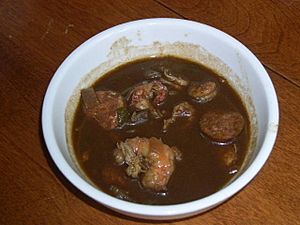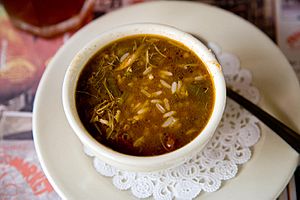Gumbo facts for kids
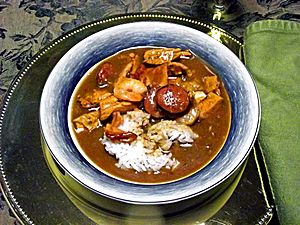
A bowl of shrimp, chicken and sausage gumbo, served with rice
|
|
| Alternative names | Gombo |
|---|---|
| Type | Soup |
| Place of origin | United States |
| Region or state | Louisiana |
| Serving temperature | Hot |
| Main ingredients | Stock, roux, okra, filé powder, meat or shellfish, celery, onions, bell peppers |
Gumbo is a super popular and official state dish of Louisiana, a state in the United States. It's a thick, flavorful soup or stew that mixes different ingredients and cooking styles from African, French, Spanish, and Native American cultures.
Gumbo usually has a rich broth, meat or shellfish, and a special thickener. It also includes what cooks call the "holy trinity": celery, bell peppers, and onions. Gumbo often gets its thickness from either okra or filé powder (which is made from ground sassafras leaves).
There are different kinds of gumbo. Some use a dark roux (a mix of flour and fat) for thickening, especially in New Orleans. Creole gumbo often has shellfish and sometimes tomatoes. Cajun gumbo usually has a dark roux and uses shellfish or fowl (like chicken or duck). Many gumbos also include sausage or ham.
After the main base is ready, vegetables are cooked down, then meat is added. The dish simmers for at least three hours, with seafood and some spices added near the end. If you want, filé powder is added after the gumbo is taken off the heat. Gumbo is almost always served with rice. There's even a less common type called gumbo z'herbes, which is a meatless gumbo made mostly from slow-cooked greens. Just like Minestrone, every gumbo recipe can be a little different, depending on the cook!
Gumbo was first written about in 1802. It became much more popular across the U.S. in the 1970s after the United States Senate dining room added it to their menu. The famous chef Paul Prudhomme helped make it even more well-known in the 1980s.
Contents
What's in a Name? The Etymology of Gumbo
The name "gumbo" most likely comes from Africa, through Louisiana French. Experts think the dish was named after one of its two main ingredients: okra or filé.
- In some Niger-Congo languages spoken by many West African slaves, the word for okra was ki ngombo or quingombo.
- In the language of the native Choctaw people, filé (ground sassafras leaves) is called kombo.
So, the name "gumbo" probably comes from one of these words!
Different Kinds of Gumbo
Gumbo is a veritable art form in Louisiana. There are as many gumbo recipes as there are cooks.
Gumbo is a richly seasoned soup or stew that can be made with many different meats or seafood. You can use almost any combination!
- Meat-based gumbo might have chicken, duck, squirrel, or rabbit. Sometimes, oysters are added too.
- Seafood-based gumbo usually has shrimp, crab meat, and sometimes oysters.
- Andouille sausage is often added to both meat and seafood gumbos. It gives the dish a "spicy kick, substance, and extra flavor."
Most gumbos are seasoned with onions, parsley, bell pepper, and celery. Tomatoes are sometimes used in seafood gumbo, but usually, not many other vegetables are included.
How Gumbo Gets Thick: Thickeners
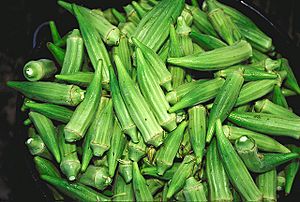

Gumbo gets its thick broth or gravy from three main ingredients: okra, filé powder, and roux. Usually, okra and filé powder are not used together in the same dish, but sometimes cooks break this rule. Roux can be used by itself or with either okra or filé.
- Okra is a slimy vegetable often used to thicken seafood gumbos. It's usually cooked first until it reaches the right consistency.
- Filé powder is made from ground sassafras leaves. It's usually added to the gumbo after it's taken off the heat. If you add it while the gumbo is boiling, it can make the gumbo too stringy. When added at the end, it gives the gumbo a slightly stringy texture.
- Roux is the most popular thickener. It's made by cooking equal parts of flour and fat (like hog lard or butter) together. The longer you cook the roux, the darker it gets and the less it thickens. A very dark roux makes a thinner sauce but with a much deeper flavor than a light roux.
Cajun vs. Creole Gumbo
Gumbo is generally split into two main types:
- Creole gumbo is common in New Orleans and southeastern Louisiana. It's named after the Louisiana Creole people, who are descendants of French, Spanish, and African immigrants. Creole gumbo often has seafood, tomatoes, and a thickener like roux.
- Cajun gumbo is common in southwestern Louisiana, where many Cajuns live. Cajuns are descendants of French-speaking settlers who were forced to leave Acadia (in modern-day Canada) in the mid-1700s. Cajun gumbo is usually known for its dark roux, cooked until it's a deep brown color. People closer to the coast often use seafood, but in other areas, chicken, duck, and sausage are popular. Cajun gumbo is often topped with parsley and green onions.
Gumbo Z'herbes: The Green Gumbo
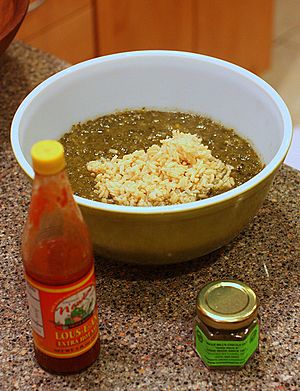
During Lent, when Catholics traditionally didn't eat meat, a meatless gumbo called gumbo z'herbes was often served. The name comes from gumbo aux herbes, meaning "gumbo of greens." This gumbo uses different greens like turnips, mustard greens, and spinach. The greens were cooked until very soft and then strained to make a thick green liquid.
Making gumbo z'herbes took a lot of time, and as Lenten rules have become less strict, this dish is not as popular today. You rarely find it in restaurants. Sometimes, ham or crabmeat is added to it now.
Gumbo z'herbes might have come from French, Spanish, or West African cooking. It's similar to the French dish potage aux herbes (soup with greens) and the African dish callaloo. It also looks a lot like a German stew made of seven different greens, often eaten on Maundy Thursday by Catholics following Lenten rules.
The Story of Gumbo: A Mix of Cultures
Gumbo is often seen as a symbol of the many cultures that came together in southern Louisiana. It combines cooking traditions from Africans, Native Americans, French, and Spanish people. In the 1700s and 1800s, people from these different cultures lived close together, sharing ideas and creating new traditions and foods.
The dish personifies the word 'Creole'; like its human counterparts, gumbo was born in the New World and took cues from the old but adapted to the new.
When New Orleans was founded in 1718, French settlers became friends with native tribes like the Choctaw. They learned about local plants and cooking methods. In 1719, slave ships brought rice and people experienced in growing it. Rice grew well in Louisiana and became a common food.
In 1721, German settlers arrived and brought their skill in making sausage. By 1746, there were more black people (slaves) than white people in Louisiana.
In 1762, Louisiana became a Spanish colony. Spanish leaders encouraged people to move there, including about 2,000 people from the Canary Islands. These fishermen brought lots of shrimp, crab, and oysters to New Orleans markets. They also loved spicy food, including cayenne pepper. Many French-speaking Acadian exiles (who later became known as Cajuns) also moved to Louisiana from Canada. Louisiana was secretly returned to France in 1800, then bought by the United States in 1803.
By 1800, the slave trade had brought new foods to Louisiana, like the African vegetable okra and hot pepper plants from Haiti. Onions and bell peppers were already part of Spanish and African cooking. Tomatoes arrived a bit later.
Where Did Gumbo Come From?
Experts agree that gumbo started in Louisiana in the early 1700s, but its exact beginning is a bit of a mystery. However, cultural clues point to a few ideas:
- African Influence: West Africans used okra as a base for many soups. In Louisiana, gumbo includes ingredients from several cultures. Records from 1764 show that African slaves in New Orleans mixed cooked okra with rice for meals.
- French Influence: Gumbo could be a spin-off of traditional French soups, like the fish stew bouillabaisse. When Acadians moved to Louisiana, they couldn't find their usual ingredients like turnips. So, they might have used local ingredients like shellfish instead of fish, and the dish changed over time.
- Native American Influence: Some experts in the early 1900s thought gumbo was a special dish for native tribes. In the late 1700s, some Cajuns served gumbo over corn grits, which was common in native stews. The use of corn and filé powder might mean the dish came from native cooking.
These ideas mix together in a local story called the Frying Pan Revolt. Legend says that in 1722, French women in New Orleans complained about not having familiar ingredients. The governor's housekeeper, Madame Langlois, supposedly taught them how to make gumbo better using okra (which slaves had introduced them to). Spanish and Choctaw people then added ingredients like rice, shrimp, crawfish, and filé powder.
How Gumbo Grew Over Time
The first times gumbo was written about were in the early 1800s. In 1802, John Sibley described "the dish they call gumbo which is made principally of the ochre into a thick kind of soop & eat with rice, it is the food of every body for dinner and supper." The next year, a French governor served 24 different gumbos at a party, showing it could be both a simple and fancy dish.
The first cookbook recipe for gumbo appeared in 1824 in Mary Randolph's The Virginia House-Wife. It was a simple recipe for boiling okra and didn't look much like the gumbo we know today.
A more familiar gumbo recipe was in an 1879 cookbook by Marion Cabell Tyree. It described "Gumbo Filit A La Creole," a filé-based gumbo with chicken and oysters. The 1881 cookbook What Mrs. Fisher Knows About Old Southern Cooking, written by former slave Abby Fisher, had three gumbo recipes. Four years later, the cookbook La Cuisine Creole listed eight kinds of gumbo.
Until the 1970s, gumbo was mostly popular along the Gulf Coast of the United States. It became famous across the country after United States Senator Allen Ellender died in 1972. Senator Ellender, from Terrebonne Parish, Louisiana, often cooked gumbo for his friends in the Senate, including five American presidents. After he passed away, the Senate cafeteria added Louisiana Creole Gumbo to its menu to honor him. Gumbo became even more popular in the 1980s when chef Paul Prudhomme made Creole and Cajun cooking famous.
Making and Serving Gumbo
Gumbo cooks for at least three hours, and often simmers all day. Meat (but not seafood) is often browned first. Okra and roux are cooked before other vegetables and seafood. Once the okra is the right consistency, it's removed, but the roux stays in the pot.
Next, seasoning vegetables are added to the sauce. When they are very soft, the meat and okra are added with water or broth. This mixture boils until the meat is tender. Seasonings like red, black, and white pepper, bay leaves, thyme, hot sauce, and salt are added to taste. Getting the seasoning just right is considered an art in Louisiana! Because seafood cooks quickly, it's added near the end. As the gumbo finishes, green onions and parsley are sometimes sprinkled on top. If you're using filé powder, it's added last, after the pot is off the heat.
Creole and Cajun gumbos are served with hot rice, which helps the dish feed more people. Gumbo z'herbes is served with rice on the side. Gumbo is almost always served right from the pot on the stove. Often, gumbo and bread are the only things in a meal, though many Cajun families also serve potato salad on the side.
Gumbo and Community
In her book Cajun Foodways, C. Paige Gutierrez says gumbo is "an economical dish" that's great for "feed[ing] a large number of people with a small amount of meat or seafood." It's a good way for cooks to use up small amounts of different ingredients that aren't enough for a single meal. Gumbo is also good for leftovers if you freeze or refrigerate it within two hours. Gumbo made without filé powder stores better because it won't get stringy.
Since the 1800s, gumbo has often been served at parties and special events in Louisiana. Local fais do-do (dance parties) often serve gumbo around midnight. Many families "have a gumbo," which means they host a casual get-together where friends and family chat, enjoy drinks, and eat gumbo.
People of all backgrounds in Louisiana make and enjoy gumbo. Its many cultural influences have helped it change and grow over the years. Gumbo is important in both cities and rural areas of Louisiana.
In rural Acadiana in southern Louisiana, gumbo is a big part of Mardi Gras celebrations. On Mardi Gras, local men go from house to house asking for gumbo ingredients in an event called courir de Mardi Gras. Then, everyone gathers in one place while the men cook the gumbo. When it's ready, the group eats and dances until midnight, when Lent begins.
Gumbo is the official state dish of Louisiana! Many cooking competitions in southern Louisiana focus on gumbo, and it's a main part of many local festivals. Bridge City, Louisiana, calls itself the "Gumbo Capital of the World" and holds an annual Gumbo Festival. This festival features gumbo cooked in a huge cast-iron pot that's 3 feet (0.9 m) deep and 5 feet (1.5 m) wide! More commonly, festival gumbo pots are 2 feet (0.6 m) deep and wide.
See also
In Spanish: Gumbo para niños


